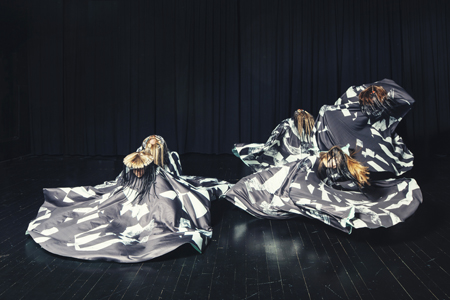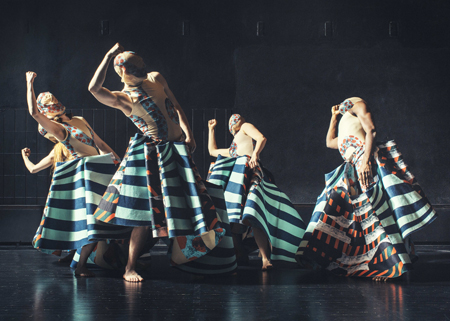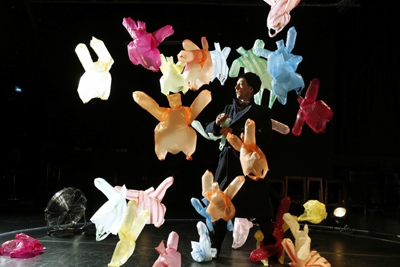Dance: Choreographing the Inanimate
By Justine Bayod Espoz
arttimesjournal April 6, 2019
 Ingri Fiksdal STATE (photo: Anders Lindén) |
When we consider the term choreography, our mind immediately jumps to dance or the image of human bodies in creative movement. But is the human body the only material on which we can capture a choreographic sequence? Two European artists are challenging this notion. The first, Ingri Fiksdal, a Norwegian choreographer, approaches the matter from a traditional dance perspective but taking into account elements aside from the body that complete the choreography, while the second, Phia Ménard, Artistic Director and founder of the company Non Nova, uses nontraditional performance and materials to explore the intricacies of choreographed movement.
Fiksdal's work STATE (2016) - presented in Chicago from February 7 - 10, 2019 in collaboration with the Chicago Museum of Contemporary Art (MCA) and the School of the Art Institute of Chicago's Fashion Resource Center and Fashion Design Exhibitions and Performance departments - explores the role of dance as ritual in society. Fiksdal's focus on ritual places a heavy emphasis on its visual aspects, predominantly the element of attire. After all, who can imagine Catholic mass without the priest's vestment? Powwows without feathered headdresses? Or a Shinto ritual without its voluminous white robes?
STATE succeeds at presenting the commonplace imagery that we've come to associate with ritualistic dance: a great deal of repetition, cyclical movement patterns and even aggressive or spasmodic displays. And it does this under oppressively low lighting that gives the entire piece a grainy patina and an unrelentingly dark mood. This combined with the noise score - so popular in contemporary performance - composed by extreme-metal artist Lasse Marhaug, successfully create a postapocalyptic trance.
 Ingri Fiksdal STATE (photo: Anders Lindén) |
The only aspect of the work that manages to transcend this otherwise jarring mise-en-scène comes at the hands of costume designer Henrik Vibskov. The choreography and much of the production's strongest imagery relies on the movement of the fabrics that drape the dancers’ bodies and how they are manipulated.
The dancers almost never leave the stage, making a display of their changing in and out of costuming. At the beginning of the piece, the dancers cover themselves with a grey blue cloth, at first crouching together to create a large block, then slowly splintering to send small fragments across the space, like a shattering iceberg. With that same fabric, the act of kneeling and maintaining the head and body rigid makes each covered dancer look like a woman hidden beneath a burka.
Beautifully, large pleated skirts with vibrant prints bob back and forth and up and down in one choreography, then unwrap to create long swathes of cloth that are manipulated like flowing shawls. The image of the whirling dervish comes and goes, you can see a matador's cape and the long, flailing, gnarled fibers of African tribal masks.
The color pallet, the texture and the movement of the dancers' garments are to a large extent, STATE's only saving graces. The viewer’s eye consistently gravitates to the undulations of the fabrics rather than the dancers manipulating them, and this is not exclusive to STATE. A wonderful flamenco dancer manipulating the large mantón (Spanish shawl) will entirely disappear behind a beautiful fluttering of silk and fringe, replaced by the wings of a butterfly made of gauze and thread. While the dancer in both of these examples plays puppeteer, is he not facilitating the choreography of an inanimate object?
 L'aprés-midi d'un foehn ( photo: Jean Luc Beaujault) |
France's Compagnie Non Nova takes this notion of choreography a step further with its short work L'aprés-midi d'un foehn set to Claude Debussy's Prelude a l'apres midi d'un faune and presented between January 23 - 27, 2019 through a collaboration between the Chicago Shakespeare Theater and the Chicago International Puppet Theater Festival. The production features anthropomorphized plastic figures, a few of which are cut and taped together out of shopping bags in front of the audience by the show's only live performer.
"What is the life expectancy of a plastic bag? How long is it actually in use? Not long at all compared to the length of time it will then stray across the planet blown and buffered by the wind," posits creator Phia Ménard in the program notes. "This is where its real life begins; its autonomous life. A little anonymous plastic bag amongst the world's countless little plastic bags, on its way to a rot-proof eternity."
The ecological considerations the serve as a foundation for the creation of this work are not necessarily its central theme. L'apr és-midi d'un foehn is a piece that allows its audience to wonder, just what are these otherwise inconsequential and disposable scraps of plastic capable of once we no longer see a use for them. Non Nova's answer is nothing short of magical.
Using a circular perimeter of fans, the puppeteer creates a wind tunnel in which one bag - later multiple bags - is given life, as it jumps, dives, pirouettes and floats. It is the humblest of spectacles, but all the same it sparks one's imagination and wonderment. How can a plastic bag be capable of such beauty? How can its dance make us marvel?
Although the idea is simple, the choreography behind
this ballet of everyday objects is complex and requires great precision,
and in many ways it rivals even the most challenging choreography created
for the human body.
